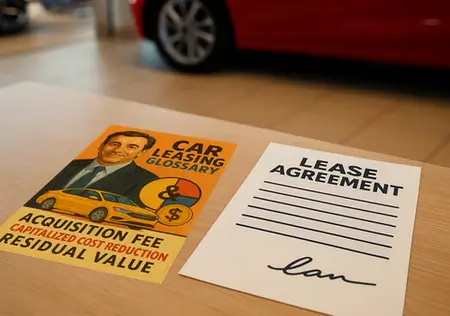Apr 01, 2025
The Complete Glossary of Car Leasing Terms: Simple Explanations for Complex Concepts
Jul 29, 2025
If you're planning to lease a car in the U.S., it's crucial to understand every term in the lease agreement before signing. Lease contracts often contain numerous specialized terms that may be unfamiliar to most customers. Not knowing them can lead to unexpected costs or complications down the road.
This glossary will help you navigate car lease terminology and understand what each term means in the context of a real lease agreement. I’ve collected the most important terms and grouped them by category, explaining each in plain English. From basic definitions to hidden fees — everything you need to know is here.
Here’s what you’ll learn:
- Jargon terms describing the terms of car leasing contracts
- Key financial terms and “lease lingo”
- Additional terminology found in lease agreements
- Terms that describe special conditions
- Definitions related to financial protection
- How to use this car lease glossary
Lease Agreement Parameters and Usage Conditions
These terms describe the structure of the lease and usage restrictions for the vehicle:

- Lessee — The individual who leases the vehicle. Responsible for making payments and following all terms of the contract.
- Lessor — The company that provides the vehicle for lease and retains ownership.
- Lease Term — The duration of the lease, expressed in months — typically 24, 36, or 48, but sometimes longer. It impacts depreciation, residual value, and the money factor. Choose the lease term that works best for you.
- Mileage Allowance — The maximum number of miles you’re allowed to drive annually (e.g., 10,000–15,000 miles), which is factored into the lease pricing.
- Excess Mileage Fee — A per-mile charge (usually $0.15–$0.30) for exceeding the annual mileage limit.
- Excess Wear and Tear — Additional charges for vehicle wear that exceeds normal use. The leasing company decides what counts as “normal.” This can include body damage, worn tires, interior stains, and other issues.
- Early Termination Fee — A penalty for ending the lease early. This often includes the remaining lease payments and extra fees — and can be a significant amount.
Key Financial Terms
These are the core concepts that determine your monthly payments and the total lease cost:
- MSRP (Manufacturer’s Suggested Retail Price) — The vehicle’s retail price recommended by the manufacturer. It’s the starting point for calculating depreciation and residual value. A higher MSRP usually means higher lease payments.
- Cap Cost (Capitalized Cost) — The actual negotiated price of the vehicle used in lease calculations. It can be lower than the MSRP due to discounts or negotiations.
- Cap Cost Reduction — Any amount that lowers the capitalized cost. This includes down payments, rebates, trade-in credits, and special lease incentives.
- Adjusted Capitalized Cost — The final amount financed through the lease. It equals the gross capitalized cost minus any reductions such as down payments or trade-ins.
- Residual Value — The car’s estimated value at the end of the lease term. It’s set by the leasing company and depends on the vehicle’s make, model, and lease duration. A higher residual value results in lower monthly payments.
- Depreciation — The loss in vehicle value over the lease term. This is the largest component of your monthly payments.
- Monthly Payment — The total amount you pay each month for the lease. It includes depreciation, interest (rent charge), taxes and fees.
- Money Factor (MF) — The lease’s interest rate, expressed in decimal form. To convert to an annual percentage rate (APR) on a loan, it must be multiplied by 2400. The lower the MF, the less interest you pay.
- Rent Charge — The interest portion of your monthly lease payment, based on the money factor and the amount financed.
Terms Related to Additional Fees and Charges
These fees often appear in the fine print and can significantly affect your lease’s total cost:
- Acquisition Fee — A one-time fee charged by the leasing company to initiate the lease. It typically ranges from $390 to $850 and is usually non-negotiable.
- Disposition Fee — A fee charged when returning the vehicle at lease-end, unless you buy the vehicle or lease another one from the same company.
- Security Deposit — A refundable deposit that covers potential excess wear or unpaid charges. Some leasing companies offer lower money factors if you make multiple security deposits (MSDs).
- Down Payment — An upfront payment that reduces the capitalized cost and lowers your monthly payments, but increases your initial out-of-pocket expenses. You can estimate its impact using our Lease Down Payment Impact Calculator.
- Sales/Use Taxes — These vary by state. Some states tax the entire lease upfront; others tax monthly payments.
- Tax, Title, and License Fees (TTL) — Fees required for vehicle registration and titling. These are state-specific and may be paid upfront or rolled into the lease.
Negotiation and Dealer Incentives
These terms often appear in dealership negotiations or promotional offers:
- Dealer Incentives — Discounts or rebates offered by the dealer or manufacturer, including cash rebates, loyalty rewards, or conquest bonuses for switching brands.
- Disposition Fee Waiver — A dealership may waive the lease return fee if you sign a new lease with them.
- Trade-In Discount — If you trade in your used vehicle, its equity can be used to reduce the capitalized cost of the new lease. Make sure the trade-in value is fair and clearly documented.
- One-Pay Lease — A lease paid in full upfront, often with a discount on the total lease cost.
- Lease Pull-Ahead Program — Allows you to terminate your current lease early without penalties if you enter into a new lease with the same manufacturer.
Special Lease Conditions
Some lease agreements contain hidden details that you should understand:
- Trade-In Equity — The positive difference between your trade-in value and the loan balance. It can reduce your new lease’s capitalized cost.
- Closed-End Lease — The most common lease type. You return the vehicle at lease-end with no further financial obligation, provided there’s no excessive wear or mileage overages.
- Open-End Lease — A lease where you’re responsible for paying the difference if the actual vehicle value at lease-end is less than the estimated residual value. This type is riskier for the lessee and more common in commercial leases.
Buying the Vehicle at Lease-End
If you plan to purchase the car after the lease ends, these terms are critical:
- Purchase Option Price — The pre-agreed price you can pay at lease-end to buy the vehicle. It’s stated in your lease contract.
- Buyout — The process of purchasing the leased vehicle, either at lease-end or earlier, depending on the terms.
- Buyout Option — Your contractual right to purchase the vehicle, typically at the residual value defined as the Purchase Option Price.
- Lease-End Negotiation — Some leasing companies allow you to negotiate the buyout price, extend your lease, or transition to a new lease at the end of the term.
Buying the Vehicle at Lease-End
If you plan to purchase the car after the lease ends, these terms are critical:
- Purchase Option Price — The pre-agreed price you can pay at lease-end to buy the vehicle. It’s stated in your lease contract.
- Buyout Option — Your contractual right to purchase the vehicle, typically at the residual value defined as the Purchase Option Price.
- Lease-End Negotiation — Some leasing companies allow you to negotiate the buyout price, extend your lease, or transition to a new lease at the end of the term.
Insurance and Protection
Some lease terms relate to financial and insurance protections in case of theft, damage, or other risks:
- GAP Insurance — Covers the difference between your lease payoff amount and the car’s market value if the vehicle is stolen or totaled.
- Deductible — The amount you must pay out of pocket before your insurance kicks in. Applies to collision or comprehensive coverage.
- Wear & Tear Protection — Optional coverage that protects you from extra charges due to normal or excessive wear. May be bundled or sold separately.
- Liability Insurance — Legally required coverage in most U.S. states. Pays for damage or injury you cause to others.
How to Understand Lease Terminology
The best way to understand leasing terms is to read your lease agreement carefully and refer to clear resources like this guide. If you come across unfamiliar language, don’t hesitate to ask the dealer to explain it in simple terms.
Final Thoughts
Understanding leasing terminology — such as MSRP, residual value, money factor, acquisition fee, and disposition fee — gives you more control when deciding whether to lease or buy. Whether you're signing your first lease or renewing, being familiar with these terms helps avoid costly mistakes and leads to smarter financial decisions.
Remember: leasing isn’t just about the monthly payment — it’s about understanding the full contract. Review key sections, ask questions, and keep this glossary handy. Knowing the language of car leasing builds confidence and saves money.







